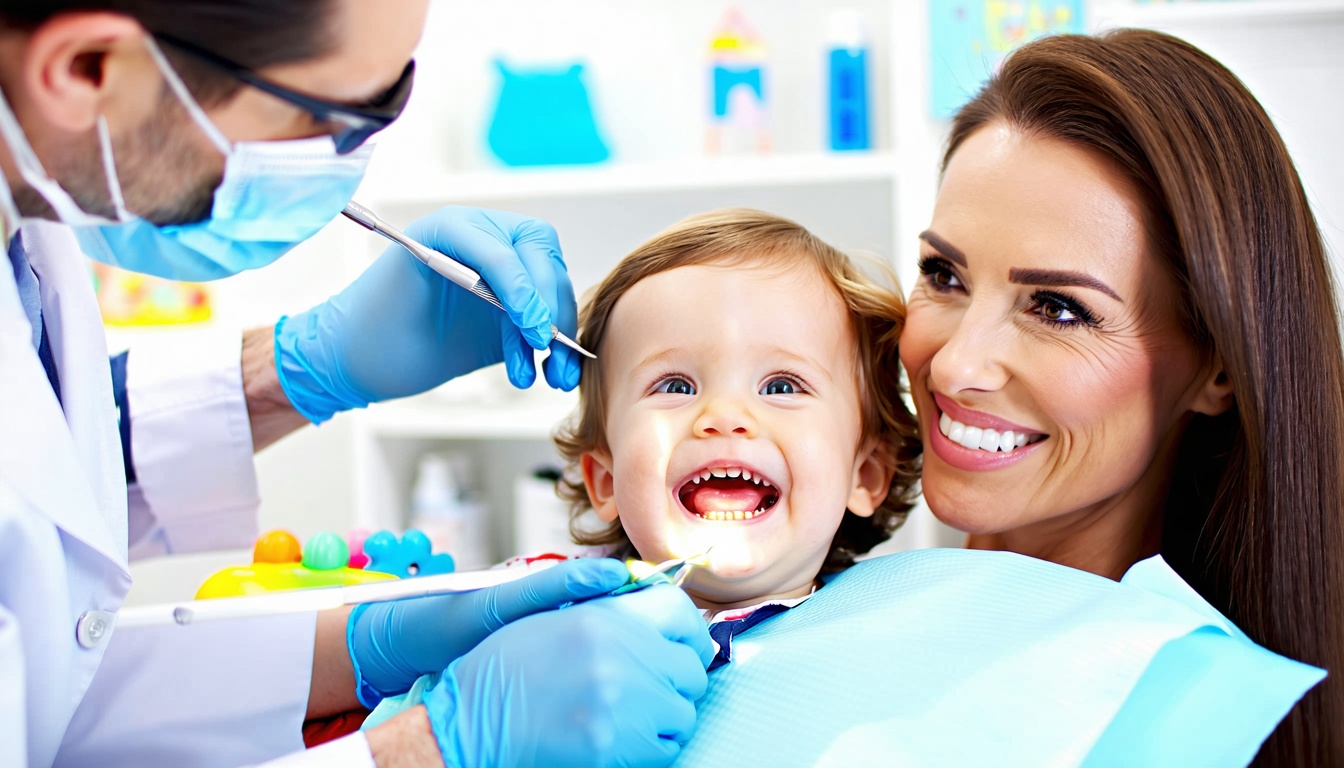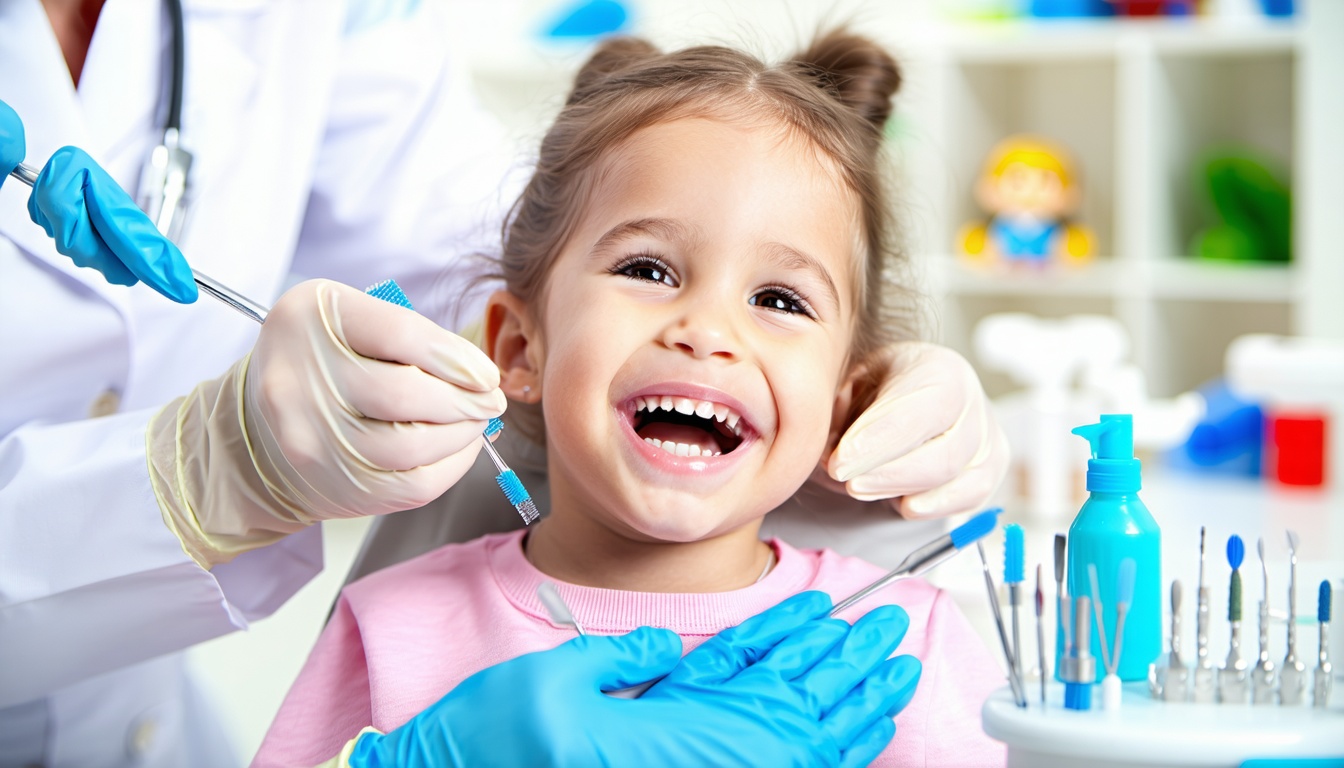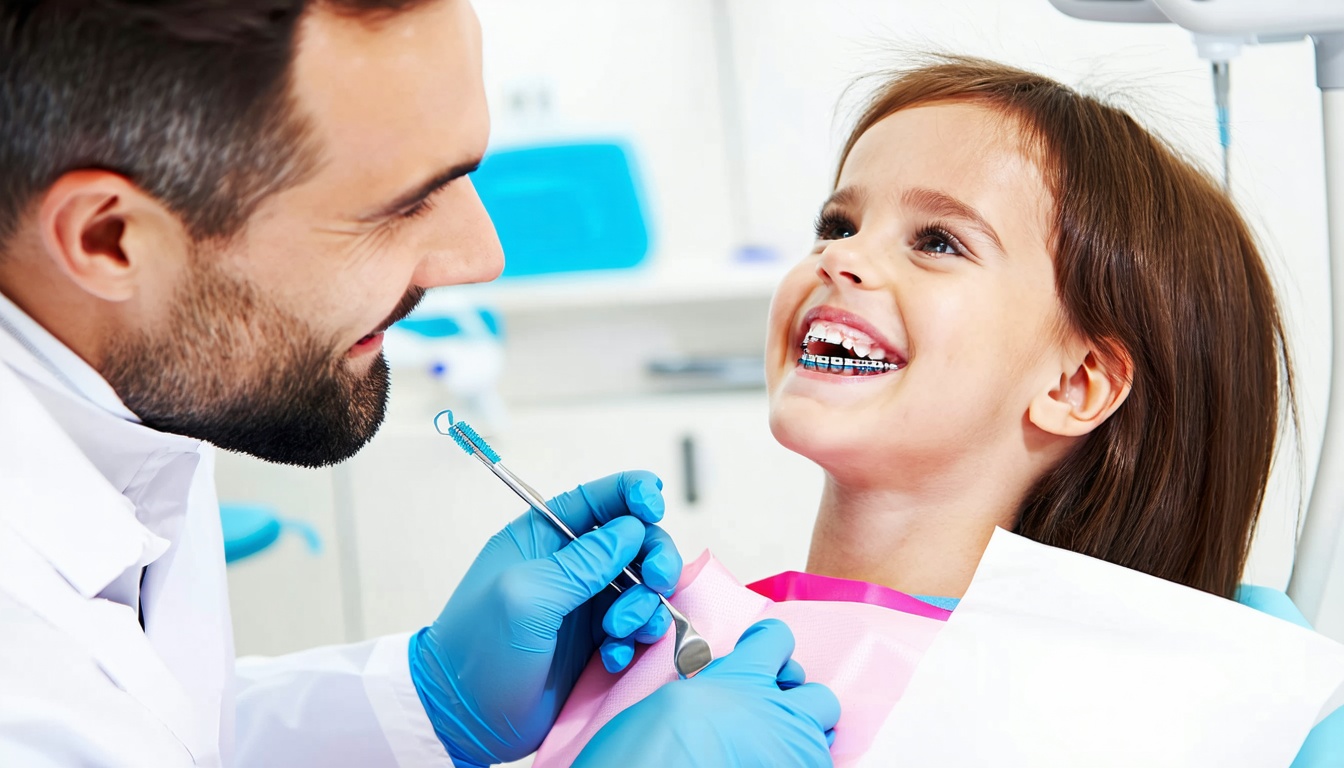Comprehensive Dental Care for Children
Understanding Pediatric Dental Emergencies
Pediatric dental emergencies can arise unexpectedly, requiring immediate attention to prevent further complications. Common types of emergencies include broken teeth, dental avulsion (when a tooth is completely knocked out), dental intrusion (when a tooth is pushed into the gums), persistent toothaches, tooth sensitivity, and root fractures. Each of these conditions can cause significant pain and discomfort for your child, making it essential to seek prompt care from an experienced emergency pediatric dentist near me.
Here’s a quick overview of common pediatric dental emergencies:
| Emergency Type | Description | Immediate Action Needed |
|---|---|---|
| Broken Tooth | A tooth that has cracked or fractured | Rinse mouth, seek dental care |
| Dental Avulsion | A tooth that has been completely knocked out | Handle tooth by the crown, keep it moist, seek dental care immediately |
| Dental Intrusion | A tooth that has been pushed into the gum | Avoid moving the tooth, seek care |
| Tooth Sensitivity | Pain from sensitivity to temperature or sweets | Avoid triggers, consult a dentist |
| Persistent Toothache | Ongoing pain that may indicate infection or decay | Schedule an urgent dental appointment |
Importance of Immediate Dental Care
Immediate dental care during a pediatric emergency is critical for several reasons. First, prompt treatment can prevent further damage to the affected tooth and surrounding structures. For example, immediate attention to a chipped or cracked tooth can help prevent infection and reduce the need for more extensive dental procedures (Extra Context). Rinsing the mouth with warm water and applying cold compresses can help alleviate pain until professional help is available.
Moreover, addressing dental emergencies quickly helps mitigate pain for your child, ensuring they remain comfortable and free from distress. Establishing strong dental habits and understanding the importance of regular dental visits can significantly reduce the chances of such emergencies. Regular check-ups allow your dentist to identify potential issues early before they escalate into emergencies.
For preventive measures, encourage your child to wear mouthguards during sports activities, childproof your home to minimize hazards, and avoid allowing them to chew on hard items like ice and hard candy. Maintaining good oral hygiene practices can also help in preventing accidents and emergencies, contributing to your child’s overall wellness.
By choosing a reliable practice like Belvedere Dentistry, you are taking a significant step toward ensuring that your child receives the best dental care available, especially in emergencies. Consider reaching out to family dentist near me or pediatric dentist near me for routine care and to develop a plan for emergency situations.
Handling Pediatric Dental Emergencies
When a dental emergency arises, quick action can make a significant difference in minimizing damage and relieving pain. Here are essential steps for handling various pediatric dental emergencies.
Steps for Knocked-Out Permanent Teeth
If your child’s permanent tooth gets knocked out, immediate action is crucial. Follow these steps to increase the chances of saving the tooth:
- Act Quickly: Aim to seek dental treatment within 1 hour of the incident.
- Handle the Tooth Carefully: Pick up the tooth by the crown, avoiding touching the root.
- Keep it Moist:
- Reinsert the tooth back into its socket if possible.
- If reinsertion isn’t feasible, place the tooth in a clean holder with milk or the child’s saliva until you reach the dentist.
For more details, refer to Nationwide Children’s Hospital.
Immediate Treatment for Chipped or Cracked Teeth
When your child chips or cracks a tooth, get them to the dentist as soon as possible. Here’s what you can do in the meantime:
- Rinse the Mouth: Use warm water to rinse your child’s mouth gently to clean the area.
- Bring Tooth Fragments: If there are pieces of the tooth, bring them along to the dental appointment.
- Avoid Further Damage: Until you can see the dentist, ensure your child avoids biting down on the affected area.
Prompt dental treatment helps prevent infection and reduces the need for more extensive dental work. More information can be found at Nationwide Children’s Hospital.
Managing Toothaches in Children
Toothaches can be distressing for children, and handling them promptly is essential. Here are steps to take:
- Rinse with Warm Water: Encourage your child to rinse their mouth with warm water to clean it.
- Avoid Direct Heat or Aspirin: Do not apply a heating pad or use aspirin directly on the tooth or gums, as it may worsen the situation.
- Seek Professional Help: Make an appointment with your child’s dentist if the pain persists.
For more urgent care situations, contact an emergency pediatric dentist near you.
Taking immediate action can make all the difference in addressing pediatric dental emergencies. Always remember to keep your child’s dental care needs a priority, and consult a professional when needed. For referrals, check out listings for family dentists near you or pediatric dentists near you.
Preventing Pediatric Dental Injuries
Taking preventive measures to guard against pediatric dental injuries is essential for your child’s oral health. This section outlines key strategies to minimize risks and promote healthy dental habits.
Importance of Mouthguards in Sports
Wearing mouthguards is crucial for children participating in sports activities. They act as protective barriers, shielding teeth from impact and reducing the risk of injuries. According to Nationwide Children’s Hospital, mouthguards can significantly lower the incidence of dental emergencies caused by falls or collisions during sports.
| Type of Sport | Mouthguard Recommendation |
|---|---|
| Football | Yes |
| Basketball | Yes |
| Hockey | Yes |
| Soccer | Yes |
| Baseball | Recommended |
Choosing the right mouthguard can make a substantial difference in protecting your child’s teeth. Consider consulting with a dentist for custom-fitted mouthguards tailored to your child’s needs. For more on dental protection, check our page on mouth guards.
Childproofing for Injury Prevention
Creating a safe environment at home can help prevent dental injuries. Childproofing measures include removing hard items that may be hazardous, such as ice, hard candy, and popcorn kernels. This approach helps to reduce the risk of accidental dental injuries, allowing your child to enjoy snacks safely. Regular dental visits can also keep your child’s dental health on track, addressing potential issues before they escalate.
| Childproofing Tips | Description |
|---|---|
| Remove hard items | Avoid foods that pose a risk of dental injury. |
| Secure sharp objects | Keep sharp objects out of reach. |
| Install safety gates | Prevent falls in and around the home. |
By actively childproofing, you contribute to a safer living space, fostering good oral hygiene practices and helping your child maintain a healthy smile.
Good Oral Hygiene Practices
Instilling good oral hygiene habits from an early age is vital for your child’s long-term dental health. Encourage regular brushing and flossing to eliminate plaque and prevent cavities, which can lead to dental emergencies. Establishing a consistent routine will teach your child the importance of maintaining healthy teeth and gums.
| Oral Hygiene Tips | Recommended Practices |
|---|---|
| Brushing | Brush twice daily with fluoride toothpaste. |
| Flossing | Floss daily to remove debris between teeth. |
| Dental Check-ups | Schedule regular appointments with a pediatric dentist near me. |
Incorporate these habits into daily life to create a strong foundation for your child’s oral health. By following these preventive measures, you can reduce the risk of pediatric dental emergencies and contribute to your child’s overall well-being.
For further information related to dental care, consider visiting our pages on teeth cleanings, fluoride treatments, and general dentistry.
Expert Pediatric Dental Services
Finding the right care for your child is essential. Specialized pediatric dental services are designed to address the unique needs of children’s dental health, ensuring they receive the best possible care in a comfortable environment.
Pediatric Dental Residency Programs
Pediatric dental residency programs are critical for training dentists who specialize in treating children, from infants to early teens. These programs typically last 2-3 years and provide comprehensive training in several areas including advanced diagnostics, child development, and management of dental emergencies. Residents work with an average of 15-20 patients per day, focusing specifically on pediatric care (Virginia Kids Pediatric Dentistry).
As part of their training, residents gain experience in various procedures and techniques, including:
| Training Aspect | Details |
|---|---|
| Behavioral Management | Techniques to handle children’s anxiety and cooperation |
| Surgery | Exposure to oral surgery pertinent to children |
| Sedation Procedures | Training in both conscious sedation and general anesthesia |
| Special Needs Patients | Understanding and catering to the needs of children with medical conditions |
Role of Specialized Pediatric Dentists
Pediatric dentists play a crucial role in fostering a positive dental experience for children. They are specially trained in all aspects of dental care for young patients and are adept at creating a comforting and engaging atmosphere. This specialty involves not just the treatment of dental conditions but also education on preventive care and good oral hygiene practices.
According to Virginia Kids Pediatric Dentistry, these professionals offer services such as:
- Oral hygiene counseling
- X-ray evaluations
- Routine check-ups
- Cavity treatments
- Orthodontic evaluations
Their specialized training also includes medical training in anesthesiology and advanced life-saving techniques, enabling them to handle complex cases effectively.
Services Offered for Children’s Dental Health
Pediatric dentists provide a wide range of services tailored to children’s dental needs, ensuring that your child’s dental health is in expert hands. Here are some of the key services:
| Service | Description |
|---|---|
| Fluoride Treatments | Helps prevent cavities by strengthening enamel |
| Dental Sealants for Kids | Protects the chewing surfaces of back teeth from cavities |
| Regular Check-Ups | Monitoring dental health and development periodically |
| Emergency Care | Immediate treatment for dental emergencies like knocked-out or broken teeth |
| Orthodontic Services | Evaluation and treatment for teeth alignment issues |
If you want the best for your child’s dental health, consider seeking a pediatric dentist near me who can provide professional and compassionate care tailored to their needs.
Emergency Pediatric Dental Care Facilities
In the event of a pediatric dental emergency, having access to specialized care is crucial. There are dedicated facilities designed to address the unique needs of children experiencing dental issues. Below are key aspects of emergency pediatric dental care facilities, including the services offered, triage procedures, and sedation options.
Nationwide Children’s Hospital Services
Nationwide Children’s Hospital is renowned for its comprehensive pediatric dental services. They provide immediate care for urgent dental situations, ensuring that children receive the treatment they need without delay. If your child’s regular dentist is unavailable, seeking care at this hospital is advisable (Nationwide Children’s Hospital).
Some of the services offered include:
- Emergency treatment for knocked-out teeth
- Management of chipped or cracked teeth
- Toothache relief and examination
- Preventive care and education to avoid future issues
Emergency Dental Triage Procedures
Efficient triage in emergency dental care facilities ensures that patients are assessed and treated based on the urgency of their condition. For example, if a child has a knocked-out permanent tooth, the recommended steps include:
- Reinsert the tooth into the socket if possible within 30 minutes.
- Preserve the tooth in saliva or milk if reinsertion is not feasible.
- Seek professional assistance as soon as possible to improve the chances of saving the tooth (Smiles 4 Life).
Emergency care procedures prioritize the management of severe pain, trauma, and potential infections to ensure children receive immediate and appropriate treatment.
Dental Sedation and Treatment Options
In many cases, especially for young children or those with dental anxiety, sedation dentistry is utilized to make dental procedures more comfortable. Various sedation methods include:
| Sedation Type | Description |
|---|---|
| Nitrous Oxide | Also known as laughing gas, helps relax patients during procedures. |
| Oral Sedation | Administered through a pill, suitable for more extensive treatments. |
| IV Sedation | Provides deeper sedation and is used for complex procedures. |
Choosing the right sedation option is crucial and should be discussed with your pediatric dentist to ensure it aligns with your child’s needs and the nature of the treatment. If you’re looking for a “pediatric sedation dentistry near me,” ensure to consult with facilities that specialize in pediatric care.
Accessing emergency pediatric dental care is imperative for your child’s oral health. Transparency in services, triage, and sedation options ensures that families are appropriately supported during dental emergencies. Regular visits to a family dentist near me can also help prevent emergencies by catching potential issues early. If you’re interested in learning more about restorative procedures, check out our link on dental fillings.
Becoming a Pediatric Dentist
Choosing to become a pediatric dentist requires a strong educational foundation and specialized training. If you’re interested in understanding this rewarding path, here’s what you need to know.
Educational Requirements for Pediatric Dentists
To become a pediatric dentist, individuals must complete a series of educational milestones. First, a bachelor’s degree is necessary, typically with a focus on biological sciences, chemistry, physics, and human anatomy. Afterward, aspiring dentists must attend an accredited dental school for four years, where they learn essential dental knowledge and skills. Following dental school, candidates must pass required board examinations and certifications.
| Stage of Education | Duration |
|---|---|
| Bachelor’s Degree | 4 years |
| Dental School | 4 years |
| Postgraduate Residency | 2-3 years |
Many prospective pediatric dentists also gain experience through volunteering, working with children, or participating in clinical research involving child-related illnesses (Virginia Kids Pediatric Dentistry).
Specialized Training and Residency Programs
After completing dental school, individuals must enter a pediatric dentistry residency program, which typically lasts 2-3 years. This residency provides specialized training in areas crucial to pediatric dentistry, such as:
- Advanced diagnostics
- Surgical procedures
- Child development and psychology
- Management of dental emergencies
- Special needs patients
- Conscious sedation and general anesthesia
During their residency, pediatric dental residents see an average of 15-20 patients per day, focusing on delivering quality care to children (Virginia Kids Pediatric Dentistry). Clinical experiences are often conducted at facilities like Nationwide Children’s Hospital, which offers hands-on opportunities in sedation and anesthesia (Ohio State University College of Dentistry).
Benefits of Pediatric Dentistry Residency
Participating in a pediatric dentistry residency provides numerous advantages. Residents often gain access to extensive resources and support networks. For example, the partnership between Nationwide Children’s Hospital and The Ohio State University allows dental residents to benefit from an established academic environment, which may include:
- Waived tuition and fees
- A salary funded by a Graduate Medical Education (GME) program
- Opportunities to refine clinical and surgical skills in a specialized pediatric setting
These experiences not only bolster technical expertise but also enhance confidence in treating young patients (Ohio State University College of Dentistry).
Choosing the right pediatric dentist for your child’s needs is essential. If you’re looking for an emergency pediatric dentist near me, consider using the resources available at Belvedere Dentistry for comprehensive dental care tailored to your family’s needs.










